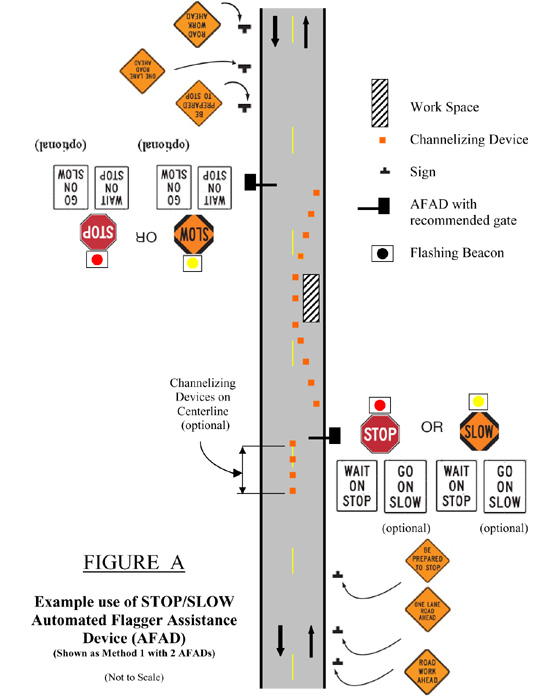
Figure A. Example Use of STOP/SLOW Automated Flagger Assistance Device (AFAD)
(Shown as Method 1 with 2 AFADs)
This figure illustrates the placement of two STOP/SLOW AFADs, channelizing devices, and signs to guide traffic around a work zone.
A two-lane, two-way road is shown with a work space and temporary traffic control zone occupying one lane. Channelizing devices have been arranged to guide traffic around the zone via the opposite lane.
At the side of the obstructed lane, three advance warning signs are placed sequentially on the shoulder of the roadway: "ROAD WORK AHEAD" (W20-1); "ONE LANE ROAD AHEAD" (W20-4); and "BE PREPARED TO STOP" (W3-4). After the signs, several channelizing devices marked "optional" are placed along the centerline of the roadway. The AFAD is adjacent to the centerline channelizing devices, and its gate arm extends to the center of the roadway.
The AFAD has STOP/SLOW signs that display alternately. The STOP sign is shown with a red flashing beacon above it; the SLOW sign with a yellow flashing beacon above it. Below each sign are two other signs: the WAIT ON STOP (R1-7) sign and the GO ON SLOW (R1-8) sign, which is marked "optional."
Just past the AFAD, in the obstructed lane, a number of channelizing devices are placed. They begin at the right edge of the lane, curve leftward around the workspace in a gradual arc, touch the centerline at the left-most point of the arc, and end at the right edge of the pavement.
On the opposite (unobstructed) lane approaching the construction zone, the three advance warning signs, the STOP/SLOW signs, and the AFAD are placed on the shoulder in the same configuration as those in the obstructed lane. There are no channelizing devices in the unobstructed lane.
